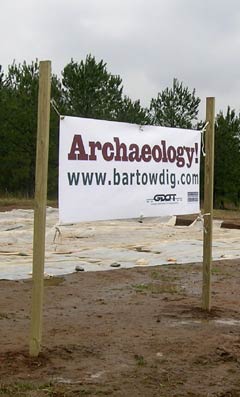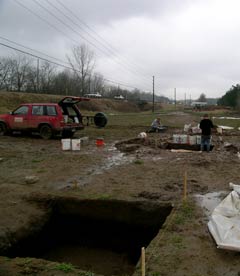- Home page
- What were you doing out there on Highway 61?
- Why did you dig there?
- Where is the site?
- Who lived there?
- What happens after the digging?
- What is archaeology?
- What is it like to work on a field crew?
- What is it like to work in the lab?
- Are there laws that protect archaeological sites?
- Ask a Native American about tribal history, archaeology, and more
- Who can I contact for more information?
- Special pages for students
- Special pages for teachers
- Special pages for archaeologists
Answering your questions
‘What did you do on Highway 61?’
It's the Leake Site Archaeological Study. Archaeological studies were conducted at the important American Indian Leake Site before the Georgia Department of Transportation (GDOT) widened Highways 61 and 113. Between 2004 and 2006, archaeologists from Southern Research, Historic Preservation Consultants, Inc. of Columbus, Georgia, excavated portions of the site that were to be impacted by the highway widening. During the fieldwork, GDOT and Southern Research (a GDOT contractor) informed the public of our findings through this web site, site tours, and the local media. One example of this outreach: Archaeology Day, an open house held in April 2005 to show the public how we uncover the past and what we were finding. There's more information on that event at this link.
The Leake (the last ‘e’ is silent) Site complex is a collection of six archaeological sites located near Cartersville, Georgia in a bend of the Etowah River. As a large mound site, Leake has been recognized since the 1890s by archaeologists as being one of the region's most important but poorly understood Native American settlements. The primary occupation of the site spans the Middle Woodland Period, dating from approximately 300 BC to AD 650, hundreds of years earlier than the famous Etowah Mounds two miles upriver.
Travelers along Highways 61 and 113 may have noticed our crews out in the field next to the road digging with a backhoe. We used heavy equipment like this to remove plow-disturbed portions of the archaeological deposits to uncover dark stains that are the remnants of Indian storage pits, posts from structures, hearths, and deep earth ovens. After using the backhoe and troweling the deposits, we mapped each stain or feature, recorded its characteristics, and excavated it. We recovered thousands of features, including many post stains from Indian structures, and ceremonial feasting and artifact production areas. Archaeological deposits from the early portion of the site occupation are referred to as Cartersville phase, while those from the latter part of the site’s occupation are from a culture archaeologists call Swift Creek. Both cultures used carved wooden paddles to impress designs into their pottery before firing it. The Swift Creek people decorated their pottery bowls and jars with complex geometric designs (see this page for pictures of this beautiful pottery). By identifying and matching similar pottery designs at different archaeological sites in Georgia and the surrounding states, we learn about interaction among Swift Creek peoples. We recovered many such broken pottery sherds and other artifacts that tell us much about this ancient culture that thrived for centuries in what is now Bartow County, Georgia.


